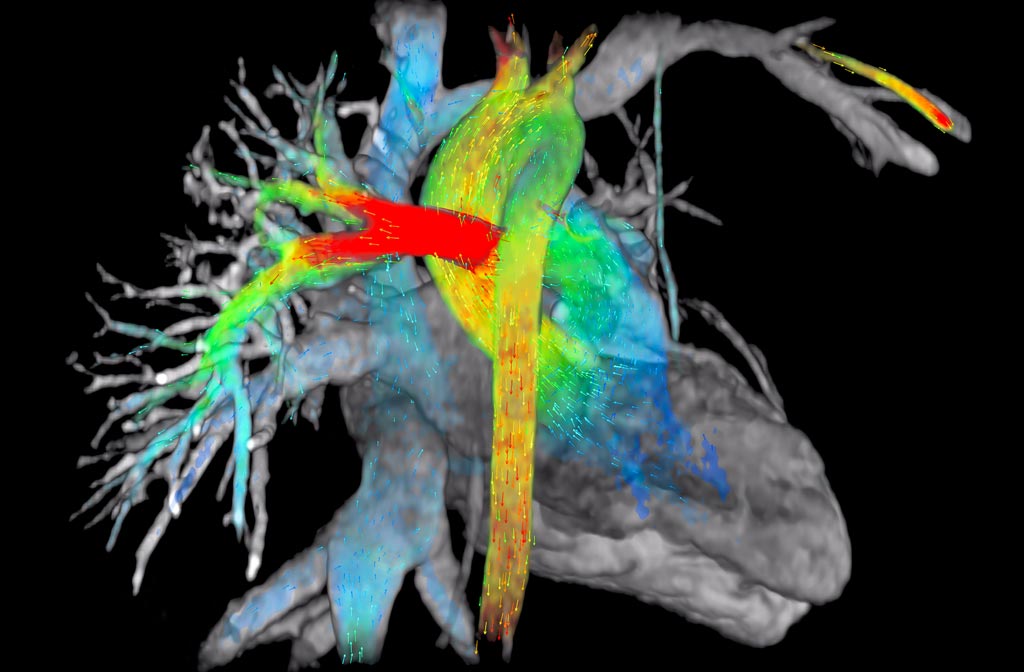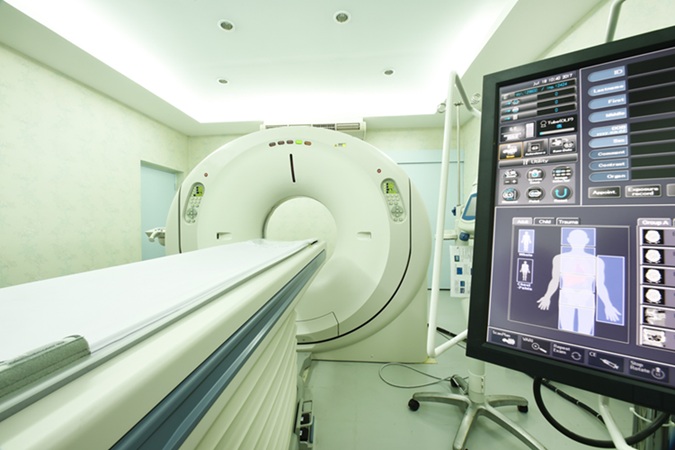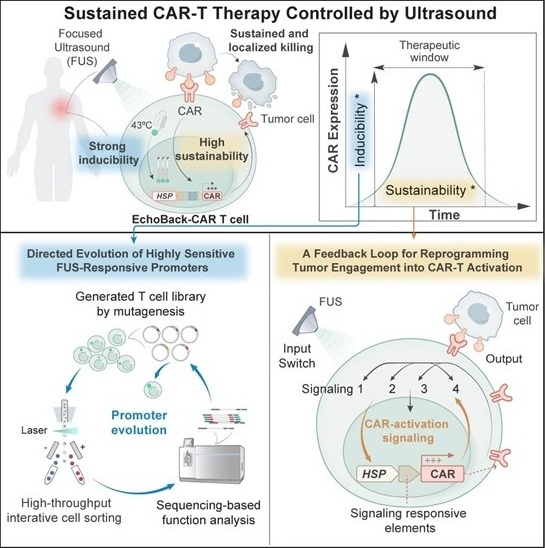CMR Improves Diagnosis of Cardiac Involvement in Lupus
|
By MedImaging International staff writers Posted on 17 Sep 2018 |

Image: A new study suggests that cardiac MRI can help detect lupus before symptoms appear (Photo courtesy of GE Healthcare).
Cardiac magnetic resonance (CMR) can be used to diagnose systemic lupus erythematosus (SLE) ahead of clinical symptoms, according to a new study.
Researchers at Goethe University Hospital (KGU; Frankfurt am Main, Germany), University Hospital Tübingen (Germany), and other institutions conducted a study in 92 consecutive patients with SLE who were free of cardiac symptoms, and undergoing screening for cardiac involvement; study participants were age and gender-matched to 78 non-SLE controls. The aim of the study was to evaluate associations between high-sensitive troponin T (hs-TropT), a marker of myocardial injury, and cardiovascular involvement using CMR with a 3T magnetic resonance imaging (MRI) scanner.
The results showed that in SLE patients, hs-TropT was significantly and independently associated with higher native T1 and T2 MRI values, aortic and ventricular stiffness, and reduced global longitudinal strain. No relationships were found between hs-TropT and age, gender, cardiovascular risk factors, duration of systemic disease, cardiac structure or function, or late gadolinium enhancement. According to the researchers, the new CMR diagnostic method can accurately detect SLE disease presence, stage, and severity. The study was published on August 4, 2018, in Annals of the Rheumatic Diseases.
“Patients with SLE have a high prevalence of subclinical myocardial injury as demonstrated by raised high-sensitive troponin levels. CMR with T2 mapping reveals myocardial edema as the strongest predictor of hs-TropT release, underscoring the inflammatory interstitial remodeling as the main mechanism of injury,” concluded lead author Valentina Puntmann, MD, PhD, of KGU, and colleagues. “Patients without active myocardial inflammation demonstrate diffuse interstitial remodeling and increased vascular stiffness. These findings substantiate the role of CMR in screening of subclinical cardiac involvement.”
SLE is an incurable systemic autoimmune disease that can affect any part of the body, but most often harms the heart, joints, skin, lungs, blood vessels, liver, kidneys, and nervous system. SLE occurs nine times more often in women than in men, is also more common in those of non-European descent. The disease is unpredictable, with periods of illness (called flares) alternating with remissions. Treatment involves preventing flares and reducing their severity and duration using corticosteroids and anti-malarial drugs.
Related Links:
Goethe University Hospital
University Hospital Tübingen
Researchers at Goethe University Hospital (KGU; Frankfurt am Main, Germany), University Hospital Tübingen (Germany), and other institutions conducted a study in 92 consecutive patients with SLE who were free of cardiac symptoms, and undergoing screening for cardiac involvement; study participants were age and gender-matched to 78 non-SLE controls. The aim of the study was to evaluate associations between high-sensitive troponin T (hs-TropT), a marker of myocardial injury, and cardiovascular involvement using CMR with a 3T magnetic resonance imaging (MRI) scanner.
The results showed that in SLE patients, hs-TropT was significantly and independently associated with higher native T1 and T2 MRI values, aortic and ventricular stiffness, and reduced global longitudinal strain. No relationships were found between hs-TropT and age, gender, cardiovascular risk factors, duration of systemic disease, cardiac structure or function, or late gadolinium enhancement. According to the researchers, the new CMR diagnostic method can accurately detect SLE disease presence, stage, and severity. The study was published on August 4, 2018, in Annals of the Rheumatic Diseases.
“Patients with SLE have a high prevalence of subclinical myocardial injury as demonstrated by raised high-sensitive troponin levels. CMR with T2 mapping reveals myocardial edema as the strongest predictor of hs-TropT release, underscoring the inflammatory interstitial remodeling as the main mechanism of injury,” concluded lead author Valentina Puntmann, MD, PhD, of KGU, and colleagues. “Patients without active myocardial inflammation demonstrate diffuse interstitial remodeling and increased vascular stiffness. These findings substantiate the role of CMR in screening of subclinical cardiac involvement.”
SLE is an incurable systemic autoimmune disease that can affect any part of the body, but most often harms the heart, joints, skin, lungs, blood vessels, liver, kidneys, and nervous system. SLE occurs nine times more often in women than in men, is also more common in those of non-European descent. The disease is unpredictable, with periods of illness (called flares) alternating with remissions. Treatment involves preventing flares and reducing their severity and duration using corticosteroids and anti-malarial drugs.
Related Links:
Goethe University Hospital
University Hospital Tübingen
Latest General/Advanced Imaging News
- AI-Powered Imaging System Improves Lung Cancer Diagnosis
- AI Model Significantly Enhances Low-Dose CT Capabilities
- Ultra-Low Dose CT Aids Pneumonia Diagnosis in Immunocompromised Patients
- AI Reduces CT Lung Cancer Screening Workload by Almost 80%
- Cutting-Edge Technology Combines Light and Sound for Real-Time Stroke Monitoring
- AI System Detects Subtle Changes in Series of Medical Images Over Time
- New CT Scan Technique to Improve Prognosis and Treatments for Head and Neck Cancers
- World’s First Mobile Whole-Body CT Scanner to Provide Diagnostics at POC
- Comprehensive CT Scans Could Identify Atherosclerosis Among Lung Cancer Patients
- AI Improves Detection of Colorectal Cancer on Routine Abdominopelvic CT Scans
- Super-Resolution Technology Enhances Clinical Bone Imaging to Predict Osteoporotic Fracture Risk
- AI-Powered Abdomen Map Enables Early Cancer Detection
- Deep Learning Model Detects Lung Tumors on CT
- AI Predicts Cardiovascular Risk from CT Scans
- Deep Learning Based Algorithms Improve Tumor Detection in PET/CT Scans
- New Technology Provides Coronary Artery Calcification Scoring on Ungated Chest CT Scans
Channels
Radiography
view channel
World's Largest Class Single Crystal Diamond Radiation Detector Opens New Possibilities for Diagnostic Imaging
Diamonds possess ideal physical properties for radiation detection, such as exceptional thermal and chemical stability along with a quick response time. Made of carbon with an atomic number of six, diamonds... Read more
AI-Powered Imaging Technique Shows Promise in Evaluating Patients for PCI
Percutaneous coronary intervention (PCI), also known as coronary angioplasty, is a minimally invasive procedure where small metal tubes called stents are inserted into partially blocked coronary arteries... Read moreMRI
view channel
AI Tool Tracks Effectiveness of Multiple Sclerosis Treatments Using Brain MRI Scans
Multiple sclerosis (MS) is a condition in which the immune system attacks the brain and spinal cord, leading to impairments in movement, sensation, and cognition. Magnetic Resonance Imaging (MRI) markers... Read more
Ultra-Powerful MRI Scans Enable Life-Changing Surgery in Treatment-Resistant Epileptic Patients
Approximately 360,000 individuals in the UK suffer from focal epilepsy, a condition in which seizures spread from one part of the brain. Around a third of these patients experience persistent seizures... Read more
AI-Powered MRI Technology Improves Parkinson’s Diagnoses
Current research shows that the accuracy of diagnosing Parkinson’s disease typically ranges from 55% to 78% within the first five years of assessment. This is partly due to the similarities shared by Parkinson’s... Read more
Biparametric MRI Combined with AI Enhances Detection of Clinically Significant Prostate Cancer
Artificial intelligence (AI) technologies are transforming the way medical images are analyzed, offering unprecedented capabilities in quantitatively extracting features that go beyond traditional visual... Read moreUltrasound
view channel
Novel Imaging Method Enables Early Diagnosis and Treatment Monitoring of Type 2 Diabetes
Type 2 diabetes is recognized as an autoimmune inflammatory disease, where chronic inflammation leads to alterations in pancreatic islet microvasculature, a key factor in β-cell dysfunction.... Read more
Ultrasound-Based Microscopy Technique to Help Diagnose Small Vessel Diseases
Clinical ultrasound, commonly used in pregnancy scans, provides real-time images of body structures. It is one of the most widely used imaging techniques in medicine, but until recently, it had little... Read moreNuclear Medicine
view channel
Novel PET Imaging Approach Offers Never-Before-Seen View of Neuroinflammation
COX-2, an enzyme that plays a key role in brain inflammation, can be significantly upregulated by inflammatory stimuli and neuroexcitation. Researchers suggest that COX-2 density in the brain could serve... Read more
Novel Radiotracer Identifies Biomarker for Triple-Negative Breast Cancer
Triple-negative breast cancer (TNBC), which represents 15-20% of all breast cancer cases, is one of the most aggressive subtypes, with a five-year survival rate of about 40%. Due to its significant heterogeneity... Read moreImaging IT
view channel
New Google Cloud Medical Imaging Suite Makes Imaging Healthcare Data More Accessible
Medical imaging is a critical tool used to diagnose patients, and there are billions of medical images scanned globally each year. Imaging data accounts for about 90% of all healthcare data1 and, until... Read more
Global AI in Medical Diagnostics Market to Be Driven by Demand for Image Recognition in Radiology
The global artificial intelligence (AI) in medical diagnostics market is expanding with early disease detection being one of its key applications and image recognition becoming a compelling consumer proposition... Read moreIndustry News
view channel
GE HealthCare and NVIDIA Collaboration to Reimagine Diagnostic Imaging
GE HealthCare (Chicago, IL, USA) has entered into a collaboration with NVIDIA (Santa Clara, CA, USA), expanding the existing relationship between the two companies to focus on pioneering innovation in... Read more
Patient-Specific 3D-Printed Phantoms Transform CT Imaging
New research has highlighted how anatomically precise, patient-specific 3D-printed phantoms are proving to be scalable, cost-effective, and efficient tools in the development of new CT scan algorithms... Read more
Siemens and Sectra Collaborate on Enhancing Radiology Workflows
Siemens Healthineers (Forchheim, Germany) and Sectra (Linköping, Sweden) have entered into a collaboration aimed at enhancing radiologists' diagnostic capabilities and, in turn, improving patient care... Read more










 Guided Devices.jpg)







